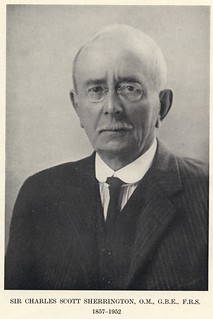- External URL
- Creation
-
Creator (Definite): Sir Charles Scott SherringtonDate: 1900
- Current Holder(s)
-
- No links match your filters. Clear Filters
-
Cited by
 T. Quick, 'Disciplining Physiological Psychology: Cinematographs as Epistemic Devices, 1897-1922', Science in Context 30 (4), pp. 423-474.
T. Quick, 'Disciplining Physiological Psychology: Cinematographs as Epistemic Devices, 1897-1922', Science in Context 30 (4), pp. 423-474.
Description:
'Sherrington’s emotion studies centred on only a single kymographic recording: that of the changing pressure of the femoral artery of a dog that he had vivisected whilst a visitor to Mosso’s laboratory (Dror 1999a, 215-216). The single line traced across the page, a comparatively flat set of undulations interrupted by a dramatic increase in magnitude in their centre, showed what Sherrington claimed to be direct evidence that emotions were not psychological representations of bodily conditions at all. Rather, Sherrington contended that emotions (which he defined as ‘feelings... excited not by a simple unelaborated sensation, but by a group or train of ideas’) played an active role in the production of bodily effects (Sherrington 1900b, 328. Cf. Dror 2006, 129-130).'
'Sherrington’s study had both normative and epistemic influence on subsequent physiological investigations relating to affect. In presenting his studies, he had related a further set of experiments on ‘spinal’ dogs (ie. dogs which had had the nerves communicating from the body to the brain severed), in which he drew inferences regarding their emotional states from their behaviours in his Liverpool laboratory (Sherrington, 1900a, 396-403). Taken together, he contended, these studies precluded the possibility that ‘higher’ emotions could be associated with anything other than cerebral processes. Whether or not the experience of emotion preceded the cerebral change, or the two were concomitant, it seemed clear to him that they were phenomena that did not proceed from an originally non-cerebral (i.e. visceral) change (Sherrington 1900b, 330; Sherrington [1906] 1947, 256-269).'
'Kymographic studies thus contributed to the replacement of the broad-ranging academic discussions of emotions and passions of the nineteenth century with the narrow, highly-focused contributions of a small community of recognised physiological and psychological specialists during the twentieth. Whilst the study of the relations of emotions to bodily processes was in Sherrington’s view one of the ‘points where physiology and psychology touch’ (Sherrington [1906] 1947, 257), the place of introspection in these fields was less certain. Sherrington spoke for many physiologists when he noted that in discussion of the results of experiments on emotion involving the manipulation of animals’ nervous systems ‘we are... hopelessly cut off from introspective help’ (Sherrington 1900b, 330).'







